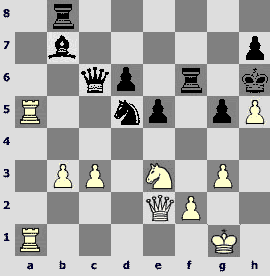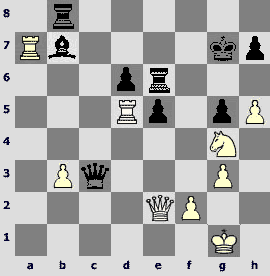20.02.2006
Linares round 2: Leko - Radjabov
Leko - Radjabov [B33] A) Now 34...Јxe3 is insufficient: 35.fxe3! (35.Јxe3 Ґxd5 36.Јd3 Ґg8 37.¦a6 ¦xb3 38.Јd1 ¦bf3 39.¦xd6 ¦xf2, and Black holds) 35...Ґxd5 36.Јd1! Ґg8 (bad is 36...Ґxb3 37.Јb1!) 37.¦d7 ¦b6 38.g4, and the b-pawn must decide the game. B) After relatively best response 34...Јc1+ 35.¦d1 Јc6 36.¤g4+ ўg7 37.¦xb7+ ¦xb7 38.¤xf6 ўxf6 39.¦xd6+ Јxd6 40.Јf3+ ўe6 41.Јxb7 Јd1+ 42.ўg2 Јxh5 43.Јc6+ ўe7 44.b4 White has serious winning chances, but there is a lot of struggle ahead. Second round summary K.Sakaev There are novelties of two types - good ones and other ones. Vallejo's idea implemented against Peter Svidler falls under the latter category. Playing 8.h4 when the situation in the center is not resolved is clearly reckless. Peter reacted strongly and got an advantage already after the opening, which was duly converted into a full point. Topalov went for a branch of the Petroff with harmless reputation, but managed to create some problems for Bacrot. There was a feeling that Black's defenses are ready to crack down, but Etienne survived and made a desired draw. Such games become rarer and rarer on a high level - one of the players won effortlessly, "on class". Levon played unusually submissive, and Vasily not only achieved a victory, but also got a boost of confidence, which can inspire him in the coming encounters. A brilliance of the second round is Leko's win against Radjabov. Recently Peter did not please his supporters too often, but here it comes - two wins in a row at the start of the Linares! It looks like a crisis is left behind, and excellent opening preparation begins to tell. We'll see if it tells tomorrow as well, as the Hungarian plays Black with Peter Svidler.
Annotated by Konstantin Sakaev
1.e4 c5 2.¤f3 ¤c6 3.d4 cxd4 4.¤xd4 ¤f6 5.¤c3 e5 6.¤db5 d6 7.Ґg5 a6 8.¤a3 b5 9.¤d5 Ґe7 10.Ґxf6 Ґxf6 11.c3 0-0 12.¤c2 Ґg5 13.a4 bxa4 14.¦xa4 a5 15.Ґc4 ¦b8 16.b3 Another popular line begins with 16.¦a2, but the text-move looks more sensible - White strengthens his position on light squares.
16...ўh8 17.¤ce3 On 17.0-0 17...f5 is good.
17...Ґe6 17...g6 is unsatisfactory in view of 18.h4! Ґxh4 19.g3 Ґg5 20.f4 exf4 21.gxf4 Ґh4+ 22.ўd2 ¤e7 23.ўc1, and it is difficult to stop the White's initiative, Topalov,V-Leko,P/Linares 2005.
18.h4! Nevertheless! In my opinion, this is the most logical move, however, it has never occurred on high level. Suddenly Black has problems with the dark-squared bishop: exchanging on e3 is unfavorable in this situation, the c1-h6 diagonal proves too short, and the bishop has no future on e7 - after possible g2-g3 it will be biting granite of the h4- and d6-pawns. If White does not bother the bishop, Black is perfectly fine: 18.Јd3 Јd7 19.0-0 g6 20.Ґb5 Јb7 21.Ґxc6, draw, Nisipeanu,L-Radjabov,T/Gothenburg 2005. The final position is even slightly better for Black.
18...Ґf4 19.¤f5! 19.h5 hands an important g5-square to Black's queen and bishop.
19...g6 20.¤fe3 An important weakening is provoked, the knight may return.
20...ўg7 One cannot cement the flank - 20...h5 21.g4!, opening up the Black's king. Simplifications also do not help - 20...Ґxe3 21.¤xe3 Ґxc4 22.¦xc4 ¤e7 23.h5 g5 24.0-0 with stable advantage for White. If 20...¤e7, then 21.h5, continuing a light-squared strategy.
21.g3 On 21.h5 Black responds with 21...Ґh6! This is the point of the previous king move - the bishop on h6 is protected, and the queen gets the g5-square.
21...Ґh6?! Safer is 21...Ґxe3 22.¤xe3 h5 23.0-0 Јd7.
22.¤g4! The hunt goes on!
22...f5 Forced, however, this break weakens the Black's king. In contrast to other typical Sveshnikov positions, here White's h-pawn also takes part in the attack, which makes a crucial difference.
23.¤xh6 ўxh6 24.h5 g5 25.exf5 Ґxf5 The king looks safe, but it is just mirage - sooner or later White will get to it.
26.¤e3 26.0-0 e4 27.¤e3 Ґh3 28.Ґd5! (but not 28.¤g4+ Ґxg4 29.Јxg4 ¤e5 30.Јxe4 ¤f3+ 31.ўg2 ¤d2 - the Black's king can relax after the White's knight is exchanged) 28...¤e5 29.Ґxe4 Ґxf1 30.ўxf1 - White has a powerful initiative for an exchange.
26...Ґc8?! A surprising decision, the bishop is transferred to the main diagonal, however, Black has no time to create anything serious - his pieces are badly coordinated and his own king is too exposed. More natural is 26...Ґe4 27.0-0 Ґf3 28.Ґe2 Ґxe2 29.Јxe2 Јd7. Ґlack's position is worse, but defendable.
27.¦a2 27.0-0 allows the Black's bishop going to h3.
27...¤e7 28.0-0 ¦f6 29.Јe2 White has a big advantage.
29...Јb6 30.¦fa1 Јc6 31.¦xa5 Time to have a snack.
31...Ґb7 32.Ґd5 ¤xd5

33.¦xd5! Very strong! A completely different game occurs after 33.¤xd5 ¦bf8, and Black creates counterplay.
33...Јxc3 34.¤g4+ Immediate 34.¦a7 is possible.
34...ўg7 35.¦a7 ¦e6 35...Јc1+ 36.¦d1 Јc6 was necessary, transposing into the queen ending given in the annotation to White's 34th move.

36.Јc4! The winning move.
36...Јe1+ The ending 36...Јxc4 37.bxc4 is hopeless for Black: White plans ¦d5-b5, completely tying up his opponent.
37.ўg2 ¦e7 38.¦xb7 ¦exb7 39.¦xd6 The Ґlack's king is all alone.
39...¦f8 40.h6+ ўh8 41.Јd5 ¦bb8 42.Јd3 Јb4 43.¦d7 e4 44.Јd5 ¦b5 45.¤f6 Black resigned.
Vallejo-Svidler.
Topalov-Bacrot.
Ivanchuk-Aronian.
Leko-Radjabov.
